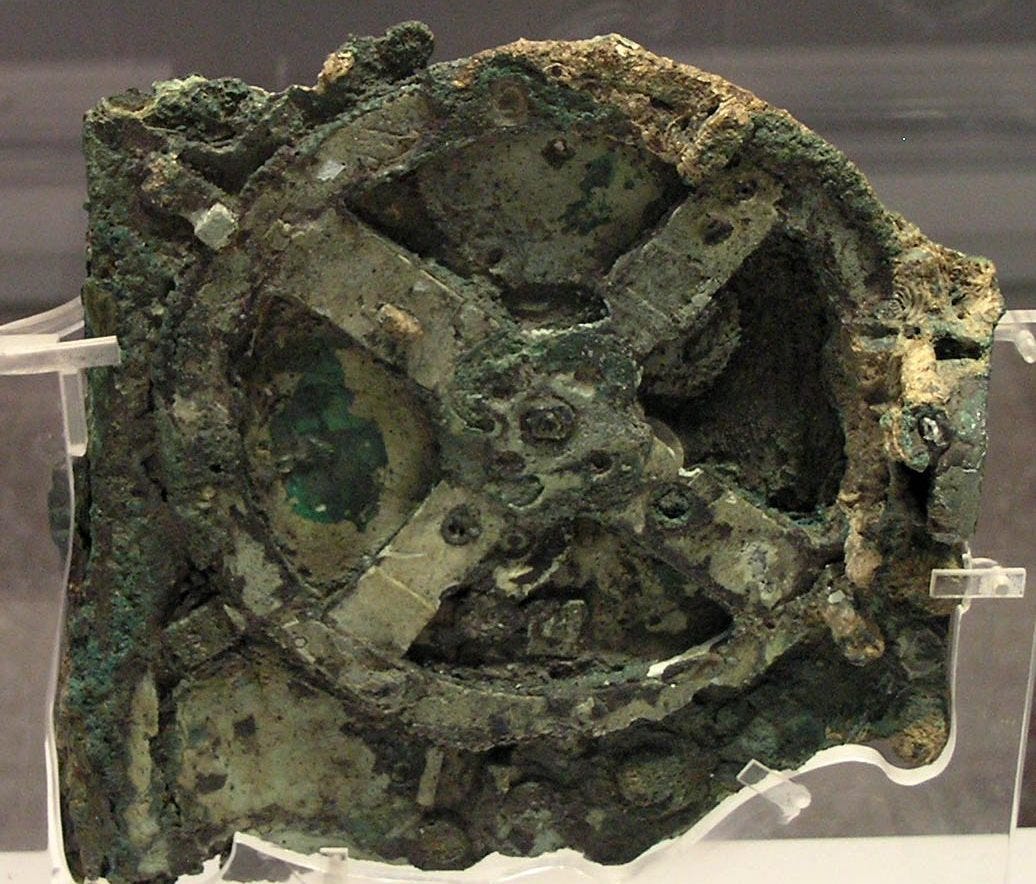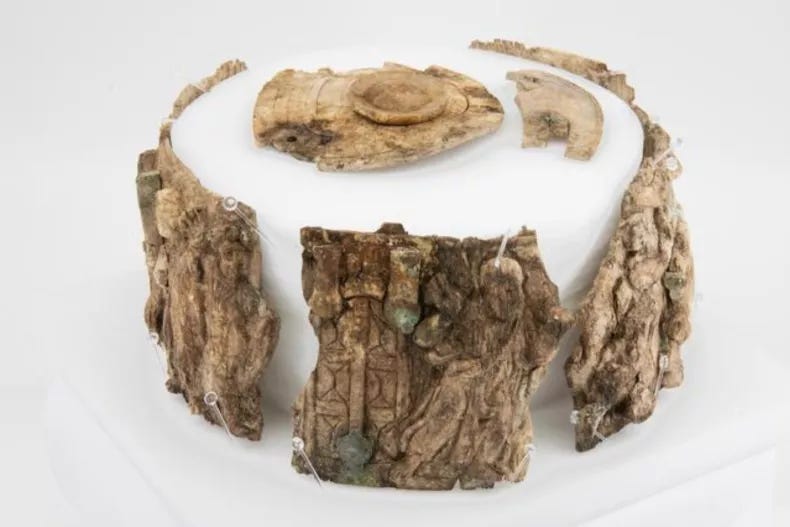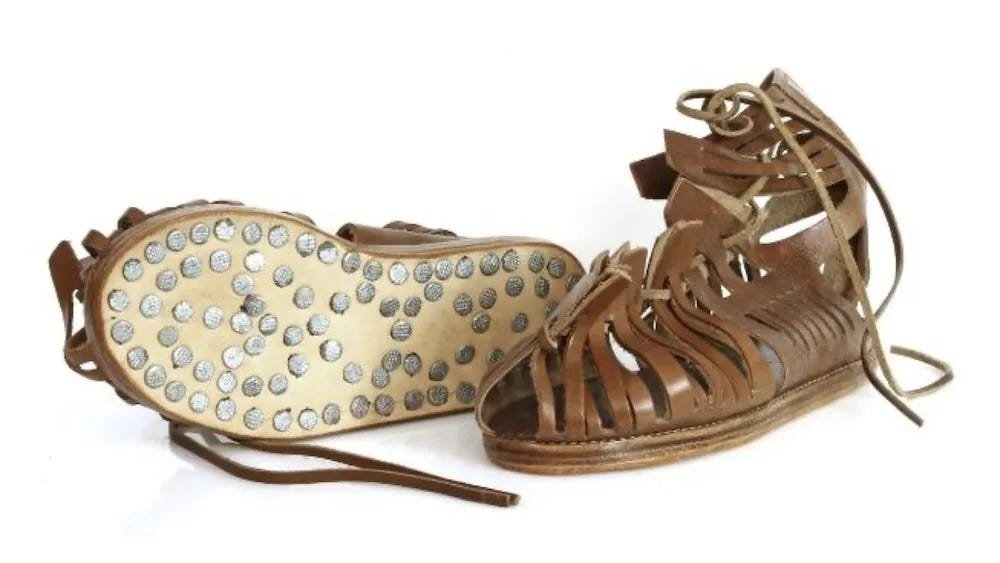Hey everyone,
Been a busy week over here in Los Angeles. How are you all doing?
This week, in history acting unruly…
Gosh I love this: We’re possibly a little closer to understanding the Antikythera Mechanism. Using statistical modeling techniques (couldn’t be me), astronomers at the Univerity of Glasgow have determined the probable number of holes on one of the broken rings of the mechanism. By several orders of magnitude, modeling indicates that the ring had 354 holes, which corresponds to the Greek lunar calendar. This furthers ideas that it was designed to be some kidn of astronomical implement.
If you can read and… do??? math, here’s the original journal article.

The Antikythera Mechanism on display. Image source: University of Glasgow
A Matisse painting is being returned to the Jewish heirs of man who sold it while fleeing Nazi Germany. I think this is particularly interesting because it’s easy to make a case for restitution when possessions were stolen by Nazi invaders, but this particular piece was sold by the owner. The investigation by the Dutch Restitutions Committee established that the original owner, Albert Stern, was forced to sell it to survive and get his family out of Germany.
Who is this mysterious woman buried with 22 warrior monks in Spain? Anthropologist Carme Rissech believes that she was a female warrior, even though many people are already trying to discredit that and reduce her to a servant.
Geisha are not prostitutes. Let me say it again: Geisha are not prostitutes. Okay—but because of that misunderstanding, these women have been being harrassed by tourists as Japan faces record numbers of tourists in 2023 and 2024. Now tourists are being banned from parts of Kyoto because of their bad treatment of gieshas.
The world’s earliest needles made from ground-stone were found in a Tibetan plateau. They’re an estimated 9,000 years old, which would change the face of sewing history. But not everyone is convinced that the objects are in fact needles.
A study of an authenticated strand of hair has revealed that Beethoven’s body was riddled with lead, which may explain some of his health issues in life.
This groundbreaking uncovering of tombs from the ancient Silla kingdom in modern-day South Korea is changing is challenging all of our previously held notions about Korean burial practices.
You know John Muir, Daniel Boone, and Lewis & Clark. But your American history classes left out the stories of several Black explorers who helped early Americans understand the continent: Esteban, York, and James Beckwourth all deserve to join their ranks.
Marilyn Monroe’s house in Brentwood (Los Angeles) has been declared a landmark, protecting it from demolition.
Fanny Angelina Hesse revolutionized microbiology by introducing a simple kitchen staple to the science. She gets almost no credit for it.
A 1,500-year-old ivory reliquary pyx depicting scenes from the Bible was found in Austria. It was inside a church that had been abandoned and leads to the important question: Why was the reliquary—generally considered the most holy part of the church—abandoned?

Though heavily fragmented, this carved ivory pyx remains beautiful 1,500 years later. Source: University of Innsbruck In Saudi Arabia’s Tabuk region, a rare bilingual inscription from the 5th century has been found. The sign is written in both Thamudic script and early Arabic. Not only does it prove that Thamudic script was used past the 4th century CE (scholars thought it had dropped off by then), but it is also a rare indication of cultural crossing and the necessity of translation.
The National Musuem of African American History and Culture has acquired the largest collection of Charleston slave badges and has put them on display. The slave badge system was one where enslaved people could be leased by their owners to other people. It identified the owner and occupation of the enslaved person.
On a hillside in Aswan, Egypt, archaeologists have found over 30 ancient family burial tombs! In use for about 900 years, these are unlike any other tombs found in Egypt from the same period.
Do you have poor work hygiene? (Chewing on pens, bad posture, etc?) Well you’re not alone—so did the ancient Egyptian scribes!
100 years ago, the Democratic National Convention was absolute chaos.
Berenike, a buried ancient Egyptian port, is transforming what we thought we knew about the connections between various ancient civilizations.
A pair of 2,000-year-old Roman military sandals that used nails for traction was recently found in Germany. The sandals were worn by soldiers while marching; the open leather helped protect them against trench foot, though they were eventually phased out in favor of footwear that provided more protection during battle.
A 2,000 year old funerary urn contains the world’s oldest known liquid wine. I do not recommend drinking it, though the scientists believe it is not toxic. It was mixed with ashes inside a tomb that was uncovered in Spain. Studies show that it was originally a white wine, but now is red with age.
Mysteries are always fun, and this one is exciting: There might be a buried Viking ship waiting underneath a farm in Norway. Metal detectorists recently found 70 rivets that were probably designed to hold together wood planking on a ship.





